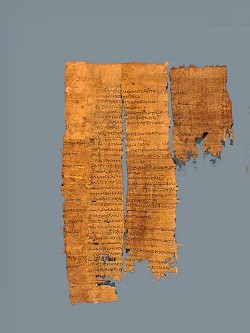
A excepción de Egipto, donde se hizo un abundante uso de los trozos de cerámica para tal menester, el papiro fue el soporte para la escritura más ampliamente utilizado por las culturas de la cuenca mediterránea. Otros materiales, como el pergamino y las tablillas ce cera o madera fueron mucho menos empleados, sólo a partir del siglo VIII d. C. comenzó a ser gradualmente reemplazado el papiro por el papel fabricado con trapos.
La papirología se dedica a estudiar los papiros y los ostraca griegos y latinos; los textos en egipcio se dejan a los especialistas en egiptología. La labor más importante de la papirología es el cuidadoso desciframiento del texto de un papiro y la realización de una transcripción del mismo. Los investigadores se encuentran a veces enfrentados a la falta de secciones que, en ocasiones, pueden ser reconstruidas mediante comparación con otros textos. Esta reconstrucción es utilizada después como base para una traducción, en la que todas las peculiaridades del papiro se discuten en un comentario. La intención principal de la papirología es la publicación de materiales que servirán de fuentes y, por lo tanto, hacer éstas asequibles para un estudio posterior.
La papirología es importante para la historia del antiguo Egipto porque proporciona mucha información sobre la vida en Egipto durante la Época Ptolemaica y el Período Romano. Por ejemplo, podemos tener una idea de las condiciones diarias de vida en los poblados así como de los principales ciclos económicos acaecidos durante esos períodos, o del desarrollo del sistema legal. Los papiros son interesantes para la historia de la religión egipcia porque son una fuente de información para el estudio de la piedad personal en forma de canciones, oraciones o textos mágicos, o para el estudio del cristianismo primitivo. Además, los papiros proporcionan información sobre el desarrollo de la lengua y la escritura griega. La papirología como disciplina científica ha celebrado recientemente su primer centenario. Ha proporcionado una enorme cantidad de información y ha conseguido que en vez de releer a los autores clásicos se puedan consultar las fuentes directas.